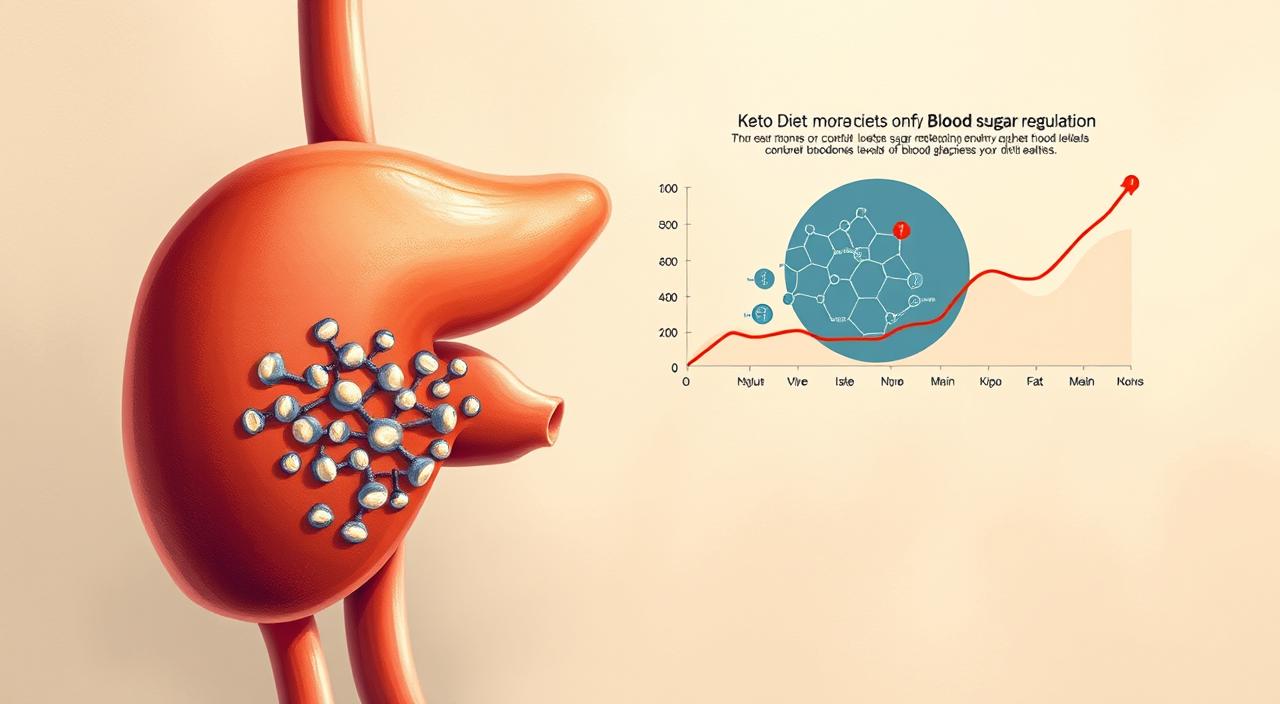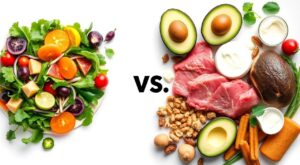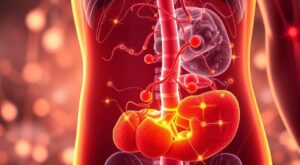Have you ever thought about which diet is better for health: Paleo or Keto? Exploring these diets, you’ll find they each have special benefits for different lifestyles and health goals. Both focus on whole foods and avoid processed items, but they differ in their approach and nutrients.
Are you curious about the Paleo diet benefits and Keto diet advantages? Let’s find out which one fits your needs best.

Introduction to Popular Diets
The world of popular diets has changed a lot in recent years. It’s now a big part of many people’s health and wellness plans. When looking at different health trends, it’s clear that what we eat affects our weight, energy, and overall health.
Diets like the Paleo and Keto are getting a lot of attention. They offer unique ways to eat that appeal to many. Understanding these diets can help you reach your health goals.
Many people want to try these diets because they fit their lifestyle and improve their metabolism. Knowing what each diet includes and what foods to avoid is key. It helps you make choices that are good for your health.
Understanding the Paleo Diet
The Paleo diet, also called the caveman diet, focuses on foods our ancestors ate. It’s based on the idea that our modern diet is not good for us. People who follow this diet eat whole, natural foods and avoid processed ones.
Definition and Principles of the Paleo Diet
The paleo diet definition is about eating like our Paleolithic ancestors. It’s all about lean meats, fish, fruits, veggies, nuts, and seeds. It’s about quality and nutrition. Grains, legumes, dairy, refined sugars, and processed foods are out.
Foods Included in the Paleo Diet
The paleo diet foods list is long and varied. It includes:
- Lean meats like grass-fed beef, lamb, and poultry
- Fish, like salmon and mackerel, for omega-3s
- Fruits and veggies, rich in fiber
- Nuts and seeds, for healthy fats and protein
- Healthy oils like olive and coconut oil
Paleo Diet Benefits
The paleo diet benefits are many. It can help you lose weight with more protein and less carbs. It also improves blood sugar and metabolic health. Plus, it’s good for your heart, lowering blood pressure and cholesterol.
Overall, it boosts your health and energy. It’s a great choice for those who care about their health. For more info, see this resource.
Understanding the Keto Diet
The keto diet is becoming more popular. It helps you get into a state called ketosis. This happens when you eat less carbs and more fat. It makes your body burn fat instead of carbs.
By following the keto diet, you can see big changes in your health. These changes can affect your body and mind in good ways.
Definition and Principles of the Keto Diet
The keto diet cuts down carbs to 5-10% of your calories. This lets your body use fat for energy. Knowing about ketosis is key, as it helps with weight loss and blood sugar.
By eating the right amount of fat, you can reach ketosis. This is important for success on the keto diet.
Foods Included in the Keto Diet
What you eat is very important on the keto diet. Here are some foods you can have:
- Fatty fish
- Meats (beef, chicken, pork)
- Dairy products (cheese, butter, cream)
- Eggs
- Nuts and seeds
- Low-carb vegetables (spinach, broccoli, cauliflower)
It’s important to pick your foods carefully. This ensures you get the right balance and enough nutrients.
Keto Diet Benefits
The keto diet has many benefits. It can help you lose weight and control blood sugar. It’s also good for people with type 2 diabetes.
Also, the keto diet can help with epilepsy and improve your mental focus. These are just a few of the many benefits.
Paleo Diet vs Keto: Key Differences
When you compare the Paleo and Keto diets, it’s important to know their main differences. These differences help you choose which diet fits your goals better. You’ll see big differences in how much of each macronutrient you eat, what foods you can’t have, and the diet’s overall philosophy.
Macronutrient Ratios
The paleo vs keto macronutrients show a big difference. The Keto diet has a lot of fat, about 70%-90%, and very little carbs, less than 5%. This helps your body use fat for energy. The Paleo diet, on the other hand, doesn’t focus as much on ratios. It lets you eat more carbs from whole foods like fruits and veggies.
Food Restrictions
Both diets have rules, but for different reasons. The Paleo diet doesn’t let you eat grains and legumes because they weren’t in our ancestors’ diet. The Keto diet also avoids these foods because they have too many carbs. Both diets say no to added sugars, but they allow different natural sweeteners.
Overall Approach and Philosophy
The d dietary approach of each diet is quite different. The Paleo diet is about more than just food. It encourages exercise, mindfulness, and a holistic lifestyle for wellness. The Keto diet, on the other hand, is all about getting into ketosis. It focuses on the right mix of macronutrients without suggesting lifestyle changes.

Common Characteristics of Paleo and Keto
Exploring paleo and keto characteristics reveals many similarities. Both diets focus on eating whole foods. This is key for better nutrition and a healthier life.
Whole Foods Focus
Both diets push for whole foods diets. They suggest eating unprocessed foods rich in nutrients. This step is essential for better health and well-being.
Elimination of Processed Foods
Both diets also stress avoiding processed foods. They believe these foods can harm health. Switching to less processed foods helps connect with your body’s needs.
Healthier Fats
They also promote healthy fats. Foods like avocados, nuts, and oils are encouraged. These fats support energy and heart health, leading to a healthier lifestyle.
For more on the differences and benefits, check out this guide on paleo and keto diets. Knowing these diets helps you make better food choices.
Paleo and Keto for Weight Loss
Many people look at Paleo and Keto for weight loss. Both diets have gained popularity for their health benefits. Research shows Paleo can help manage weight, and Keto can lead to significant weight loss. Knowing how these diets work can help you choose the right one for you.
Effectiveness of Paleo for Weight Loss
The Paleo diet focuses on whole foods and nutrients. Studies show it can lower BMI and waist size. It encourages eating natural foods, which can help you feel full and eat healthier.
This diet is backed by paleo weight loss research. It shows Paleo can help manage weight effectively.
Effectiveness of Keto for Weight Loss
The Keto diet is high in fat and low in carbs. It aims to put your body into ketosis, a state where it burns fat efficiently. Early keto research findings suggest it can lead to quick weight loss.
By eating more fat and fewer carbs, you might eat less overall. This can help you lose weight more easily. Many find Keto to be a good choice for losing pounds.
| Diet | Weight Loss Effectiveness | Key Mechanisms |
|---|---|---|
| Paleo | Effective for BMI reduction | Promotes satiety with whole foods |
| Keto | Effective for short-term weight loss | Appetite control through ketosis |
Health Benefits of the Paleo Diet
The Paleo diet has many health benefits, like better heart health and blood sugar control. It focuses on whole foods and nutrients. This approach helps you live healthier and avoid the dangers of modern diets.
Cardiovascular Health
The Paleo diet is great for your heart. It includes lean meats, fish, fruits, veggies, nuts, and seeds. These foods help lower blood pressure and improve cholesterol.
By cutting down on processed foods and unhealthy fats, you can lower your heart disease risk.
Blood Sugar Regulation
The Paleo diet’s focus on whole foods is key for controlling blood sugar. It limits refined sugars and grains. This can help manage diabetes.
People on the Paleo diet often see better blood sugar levels. This can lower the risk of type 2 diabetes or improve health for those with it.
Health Benefits of the Keto Diet
The ketogenic diet has many health benefits, like keto blood sugar regulation and supporting brain health. It’s a low-carb, high-fat diet that can change lives. It’s great for those looking for diabetes treatment or managing brain conditions.
Control of Blood Sugar Levels
The keto diet is great for keeping blood sugar stable. It cuts down on carbs, making your body use fats for energy instead of sugar. This can make your body more sensitive to insulin, helping those with type 2 diabetes.
Many people find their blood sugar levels improve and need less medication. This shows the keto diet’s power in managing blood sugar.
Support for Neurological Conditions
The keto diet has been used for years to help with epilepsy. Studies show it can lower seizure frequency, mainly in kids who don’t respond to usual treatments. New research also suggests it may help with Alzheimer’s and Parkinson’s disease.
This shows the diet’s value goes beyond just weight loss. It’s a key way to support brain health.

Nutritional Concerns With the Paleo Diet
The Paleo diet focuses on whole foods but raises some nutritional concerns. These include possible nutrient deficiencies and the effects of eating a lot of red meat.
Potential Nutrient Deficiencies
Switching to the Paleo diet means cutting out grains and dairy. These foods are key sources of vitamins and minerals. This can lead to paleo diet nutritional deficiencies that harm your health. You might miss out on B vitamins, calcium, and vitamin D.
To avoid these deficiencies, eat a wide variety of foods. Include fruits, vegetables, nuts, and seeds. You might also need supplements to cover any dietary gaps.
High Meat Intake Considerations
The Paleo diet often includes a lot of red meat. While protein is important for muscles and health, too much can be bad. High red meat intake is linked to heart disease and other chronic conditions.
It’s important to balance your protein sources. Add lean meats, poultry, fish, and plant-based proteins to your diet. Make sure to also eat plenty of fruits and vegetables. This mix helps avoid health risks and boosts your nutrient intake.
| Nutrient | Sources in Paleo | Common Deficiencies |
|---|---|---|
| B Vitamins | Lean meats, nuts, seeds | Fatigue, anemia |
| Calcium | Leafy greens, fish | Bone density issues |
| Vitamin D | Fish, mushrooms | Weak immune function |
Nutritional Concerns With the Keto Diet
Many people are attracted to the keto diet’s benefits. But, it’s important to think about the nutritional concerns it may bring. The diet’s focus on low carbs can lead to a lack of important vitamins and minerals.
Potential Nutrient Deficiencies
One big problem with the keto diet is the risk of nutrient deficiencies. The diet’s strict carb limit can mean not enough vitamins and minerals. Key nutrients like:
- Vitamin B
- Vitamin C
- Magnesium
- Selenium
These shortages can affect your health. It’s key to eat nutrient-rich foods. You might also need supplements to keep your nutrient levels up while on the keto diet.
Impact on Liver and Kidney Health
The keto diet’s high fat intake can be a worry for those with health issues. It can put extra stress on the liver and kidneys. This can have serious effects on keto liver health and kidney strain.
People with these health concerns should be careful with this diet. It’s important to watch how your organs are doing. Drinking plenty of water and eating foods that help your liver and kidneys can help keep your body balanced on this diet.

Which is Better: Paleo or Keto?
Choosing between paleo and keto depends on your dietary needs. Each diet has its own benefits and challenges. Think about your activity level, health history, and food likes to decide which diet fits your lifestyle and goals.
Factors to Consider for Individuals
Reflect on these key factors when deciding on a diet:
- Personal health goals: Are you looking to lose weight, gain muscle, or improve overall health?
- Food preferences: Choose foods you enjoy, as liking what you eat is key to success.
- Activity level: If you’re very active, you might need different nutrients from each diet.
- Medical conditions: Talk to a doctor if health issues could affect your diet choice.
Long-Term Maintainability
For long-term success, choose a diet that’s easy to keep up with. The paleo diet might be easier to stick with because it allows for more food variety. The keto diet, with its strict carb limits, can be harder to follow long-term. Think about whether you can keep up with each diet for years.
Paleo and Keto for Beginners
Starting a new diet can be thrilling but also a bit scary. If you’re looking into the Paleo or Keto diets, knowing where to begin is key. Understanding the basics can make your transition smoother. Here are some tips and guidelines to help you start your journey.
Getting Started with the Paleo Diet
When you start the Paleo diet, it’s important to eat whole, unprocessed foods. Here are some paleo diet tips to guide you:
- Make a list of foods you can eat, like lean meats, fish, fruits, veggies, nuts, and seeds.
- Plan your meals ahead to avoid unhealthy choices.
- Use a beginner paleo guide for recipes and shopping lists.
- Adding regular exercise can help with your diet changes.
Getting Started with the Keto Diet
For those new to the Keto diet, knowing about macronutrient ratios is essential. Here are some keto diet tips to remember:
- Eat foods high in fat, moderate in protein, and low in carbs to stay in ketosis.
- Use a beginner keto guide for meal planning and tracking.
- Invest in an app or journal to track your food and meet your macronutrient goals.
- Drink plenty of water and replace lost electrolytes, mainly when you first start.

Social and Lifestyle Considerations
Dining out can be tricky when you follow paleo or keto diets. Knowing the differences helps you eat out while sticking to your diet. It’s easier to find good places to eat when you know what’s on the menu.
Eating Out on Paleo vs Keto
Paleo dining means no processed foods or added sugars. It focuses on whole, natural foods. This might make it easier to find something to eat out.
Keto dining, on the other hand, limits carbs. You need to be careful about what you order. Talking to the restaurant staff about your diet can help you enjoy your meal.
Social Isolation and Dietary Flexibility
Following paleo or keto diets can make you feel left out. Paleo might be easier to follow in social situations because of its flexibility. But keto can be harder because of its strict rules.
Finding a balance between your diet and social life is key. This way, you can enjoy eating out with friends and family.
Final Thoughts on Paleo and Keto
Choosing between Paleo and Keto diets means picking two different ways to eat. Each diet has its own ideas and benefits. A paleo vs keto summary shows how they focus on whole foods but differ in what they allow.
When looking at a diet summary, think about your lifestyle and what you like. Paleo might appeal if you want to avoid processed foods and eat natural foods. Keto could be better if you want to burn fat and get into ketosis.
Knowing the differences can help you choose a diet that fits your health goals. Whether you prefer Paleo’s focus on natural foods or Keto’s high-fat approach, both can help you feel better. Your choice should be based on what’s best for you and your lifestyle.
Conclusion
When we look at the paleo diet vs keto, we see both have their own benefits. They cater to different goals. Knowing their basics, food choices, and health impacts helps you choose wisely.
Choosing between the Paleo diet’s focus on whole foods and the Keto diet’s low-carb, high-fat approach is key. Think about how each fits into your life. Your choice should match your goals, whether it’s losing weight, improving health, or enjoying food.
The most important thing is to pick what you can stick to long-term. When deciding between paleo and keto, think about what’s best for you. A healthy lifestyle is rewarding, leading to better health and happiness.














